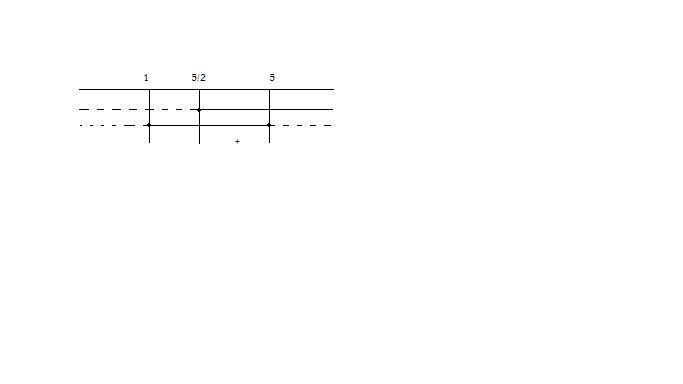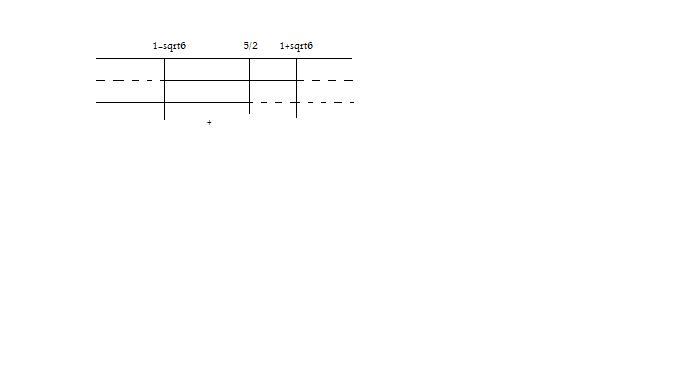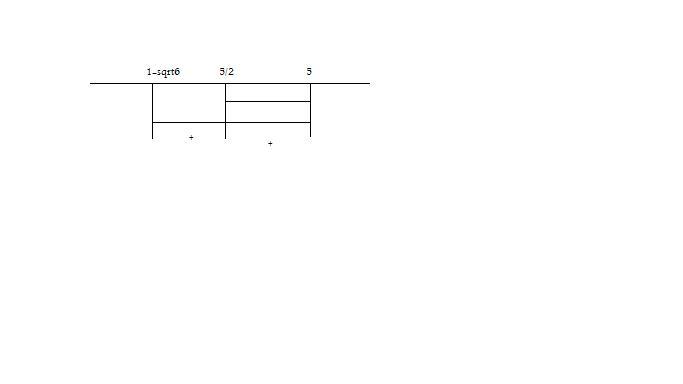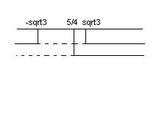[math]|2x-5|+4x>=x^2[/math]
[math]|2x-5|>=x^2-4x[/math]
Per risolvere la disequazione dobbiamo distinguere il caso in cui l'espressione
[math]2x-5[/math]
è positiva o nulla da quello in cui è negativa. Infatti
Se
[math]2x-5>=0[/math]
la disequazione è equivalente a
[math]2x-5>x^2-4x[/math]
Se
[math]2x-5>0[/math]
la disequazione è equivalente a
[math]2x-5>-x^2+4x[/math]
In definitiva, per risolvere la disequazione data, dobbiamo risolvere i due sistemi
[math]\begin{cases} 2x-5>=0 \\ 2x-5>=x^2-4x \ \end{cases} vv {(2x-5>0),(2x-5>-x^2+4x):}[/math]
;
Studiamo il primo sistema
[math]\begin{cases} 2x-5>=0 \\ 2x-5>=x^2-4x \ \end{cases}[/math]
;
[math]\begin{cases} 2x>=5 \\ -x^2+6x-5>=0 \ \end{cases}[/math]
;
[math]\begin{cases} x>=5/2 \\ x^2-6x+5>=0 \ \end{cases}[/math]
;
Studiamo la seconda disequazione
[math]x^2-6x+5>=0[/math]
[math](Delta)/4=(b/2)^2-ac=(-3)^2-(5 \cdot 1)=9-5=4[/math]
[math]x_(1,2)=(-b/2+-\sqrt{(Delta)/4})/a=(3+-\sqrt4)=(3+-2) => x_1=1 ^^ x_2=5[/math]
.
Siccome il segno del coefficiente di
[math]x^2[/math]
è concorde col segno della disequazione,
prenderemo gli intervalli esterni, quindi soluzione della disequazione sarà:
[math]x>=1 vv x>=5[/math]
.

Pertanto
[math]S_1= 5/2>=x>=5[/math]
Studiamo ora il secondo sistema
[math]\begin{cases} 2x-5>0 \\ 2x-5>-x^2+4x \ \end{cases}[/math]
;
[math]\begin{cases} 2x>5 \\ x^2-2x-5>0 \ \end{cases}[/math]
[math]\begin{cases} x>5/2 \\ x^2-2x-5>0 \ \end{cases}[/math]
Studiamo la seconda disequazione
[math]x^2-2x-5>0[/math]
[math](Delta)/4=(b/2)^2-ac=(-1)^2-((-5) \cdot 1)=1+5=6[/math]
[math]x_(1,2)=(-b/2+-\sqrt{(Delta)/4})/a=(1+-\sqrt6) => x_1=(1-\sqrt6) ^^ x_2=(1+\sqrt6)[/math]
.
Siccome il segno del coefficiente di
[math]x^2[/math]
è discorde col segno della disequazione,
prenderemo gli intervalli interni, quindi soluzione della disequazione sarà:
[math](1-\sqrt6)>x>{1+\sqrt6}[/math]
.

Pertanto
[math]S_1=1-\sqrt6>x>5/2[/math]
In definitiva quindi la soluzione è data dalle unioni delle due soluzioni, cioè:

[math]S=S_1 uu S_2 : 1-\sqrt6>x>=5[/math]
.
 Pertanto
Pertanto 









 Accedi a tutti gli appunti
Accedi a tutti gli appunti
 Tutor AI: studia meglio e in meno tempo
Tutor AI: studia meglio e in meno tempo